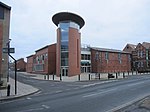Beverley railway station
1846 establishments in EnglandBeverleyDfT Category E stationsFormer York and North Midland Railway stationsGeorge Townsend Andrews railway stations ... and 9 more
Grade II listed buildings in the East Riding of YorkshireGrade II listed railway stationsNorthern franchise railway stationsPages with no open date in Infobox stationRailway stations in Great Britain opened in 1846Railway stations in the East Riding of YorkshireRailway stations served by Hull TrainsStations on the Hull to Scarborough lineUse British English from December 2016

Beverley railway station serves the market and minster town of Beverley in the East Riding of Yorkshire, England. It is located on the Hull to Scarborough Line and is operated by Northern who provide most passenger services from the station.
Excerpt from the Wikipedia article Beverley railway station (License: CC BY-SA 3.0, Authors, Images).Beverley railway station
Trinity Grove,
Geographical coordinates (GPS) Address Nearby Places Show on map
Geographical coordinates (GPS)
| Latitude | Longitude |
|---|---|
| N 53.842 ° | E -0.421 ° |
Address
Trinity Grove
Trinity Grove
HU17 0EB
England, United Kingdom
Open on Google Maps









